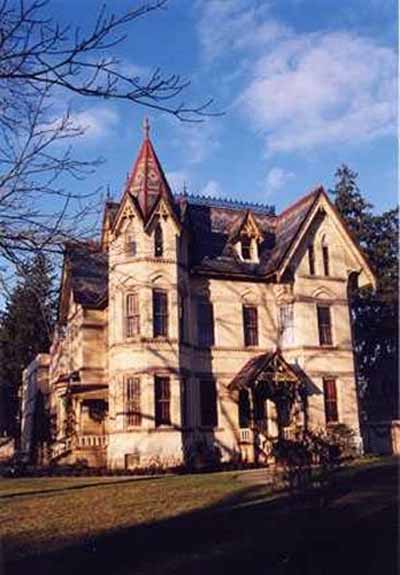Annandale House (Tillsonburg Museum) National Historic Site of Canada
Tillsonburg, Ontario

Exterior Photo
© Parks Canada / Parcs Canada, 1997
Address :
30 Tillson Avenue, Tillsonburg, Ontario
Recognition Statute:
Historic Sites and Monuments Act (R.S.C., 1985, c. H-4)
Designation Date:
1997-09-22
Dates:
-
1881 to 1882
(Construction)
Other Name(s):
-
Annandale House (Tillsonburg Museum)
(Designation Name)
Research Report Number:
1997-005
Plaque(s)
Existing plaque: Near the west door of the house 30 Tillson Avenue, Tillsonburg, Ontario
Exuberant ceiling paintings, stained glass, richly decorated fireplaces and woodwork make the interior of Annandale an excellent illustration of the Aesthetic Movement. This international movement reacted against the growing use of mass-produced decorative items in house design, and instead promoted a revival of craftsmanship. Finished in 1887, Annandale reflects the taste and aspirations of E.D. Tillson, an important entrepreneur and first mayor of Tillsonburg. The exterior shows the influence of standardized house designs on Canadian architecture in the 19th century.
Description of Historic Place
The ''pattern book'' facade of this eclectic, late Victorian house belies its quite extraordinary interior. Richly decorated with ceiling and wall paintings, stained and painted glass windows, decorative metal work and woodwork, this house is an ambitious essay in the tastes introduced by the Aesthetic Movement in Canada. The designation refers to the interior and exterior of the house on original footprint and on its legal lot as of 1997.
Heritage Value
Annandale House (Tillsonburg Museum) was designated a national historic site because:
its interior, decorated during 1883-1887 according to principles promoted by Oscar Wilde, is one of the best surviving illustrations in Canada of the Aesthetic Movement; the house itself is an excellent example of pattern book design, which had a major impact on domestic architecture in Canada; and Annandale House provides a personal link to the late-Victorian age, when industrialization was radically changing society and "household art" was often seen as an important symbol of status and taste.
Built in 1881-1882 for local entrepreneur E. D Tillson (considered the father of Tillsonburg) in southwestern Ontario, the house was intended as the manor on Tillson’s model farm (now redeveloped for suburban housing) which drew visitors from Canada and abroad. Like the farm, the house incorporated the latest in technology and design. The Tillson’s support for the 1882 visit by renowned author and aesthete Oscar Wilde to the Mechanics Institute in the nearby town of Woodstock, proved to be a decisive influence on the interior decor of the mansion. Wilde popularized the Aesthetic Movement which encouraged bringing “art” into middle-class homes through the use of a full range of media in interior decor, ideally produced by local craftspeople. The Tillsons hired Detroit decorator James Walthew, who worked on the house from 1883 to 1887. The exterior, already under construction at the time, closely conforms to plans for “Brick villa No. 2" in Villas and Cottages: or Homes for All by William M. Woollett of Albany, New York. A modern two-storey museum wing was added to the rear of the house in 1985. The building is now operated as a museum.
Source: Historic Sites and Monuments Board of Canada, Minutes, June 1997.
Character-Defining Elements
Aspects of this site which contribute to its heritage character include:
elements which speak to its interior decoration reflecting the Aesthetic Movement, specifically the exceptional cycle of interior painted decoration featuring geometric motifs, local flora and fauna, with sympathetic finishes and decoration including parquet floors of local woods, wood carving, decorative metalwork, marble-topped radiator covers, etched and stained glass, and elaborate Eastlake-inspired chimney overmantels; elements which speak to the pattern book design of the house, specifically its lively and eclectic exterior design with square two-and-a-half storey massing enlivened by projecting bay windows, balconies, porches and steep multi-coloured slate roofs, local buff brick facing material, ornate wooden millwork decoration and the centre-hall interior plan; the landscaped, park-like setting.